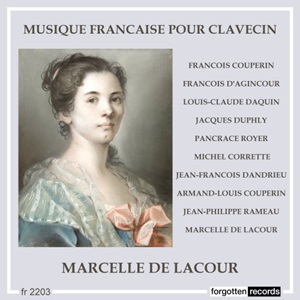
Musique Française pour Clavecin
Marcelle de Lacour (harpsichord)
rec. February 1957, Paris (Salle de la Mutualité) and December 1937 – January 1938, Paris (Couperin: Les Fastes)
Forgotten Records FR2203 [52]
Harpsichordist Marcelle de Lacour lived to the age of 100 dying as recently as 1997. She had been born in Besançon in 1896 and was a Landowska student who concentrated principally on the Baroque repertoire, though she made fruitful excursions to the neo-classicism of the twentieth-century to perform the music of Martinů, Florent Schmitt, Alexandre Tansman and Poulenc. Some of this music, indeed, was dedicated to her.
What Forgotten Records has interred is two sides of her discography. The larger part is from a Pathé LP recorded in February 1957 and the appendix is from a L’Oiseau Lyre 78 recorded in 1937-38. The repertoire reflects her strengths in French Baroque music and much of the focus is on the characterful harpsichord pieces of François Couperin. Couched as she is so strongly in the ‘Landowska School’ she makes a big robust sound on what I assume is a Pleyel, revealing both the lasting influence of the Polish harpsichordist on French musical culture and also her choice of instrument. The sound of the harpsichord is resonant and somewhat metallic and is a beast of rich timbral resource. Yet for all that Lacour sits in the robust school, she is quite capable of nuance when required, as in Les Grâces naturelles, where her changes of registration, and clarity of trills, point to a less vehement, more refined exponent. Elsewhere, her use of what I take to be the 8’ lute is refined in La Manon and her feathery articulation in La Lutine is both apposite and astute. She draws out the rich bass in the slower pieces, notably the Sarabande ‘L’Unique’.
The rest of the recital covers single pieces from a range of composers, from D’Agincour (b.1680) to Armand-Louis Couperin (b.1725). They are chosen to show variety, such as the interplay of blatancy of chording and elegant responses in the Corrette, the flourish and drama of Rameau or the intricacy of the Royer. There’s one piece by Lacour herself, the Trois airs que jouait la pendule de Marie-Antoinette, a charming waltz-like character piece no more than two minutes in length.
The 78rpm disc offers a succinct seven-minute Couperin selection from Les Fastes de la Grande et Ancienne Ménestrandise in which the music varies from vibrant bass to treble-flecked sonorities, finely captured by the engineers.
Lacour joins Forgotten Records’ recent restoration of recordings by Sylvie Spycket – whose life was as short as Lacour’s was long – in a tranche of harpsichordists on record. This opens a vista on the students, protégés and followers of Landowska and does so in excellent transfers and – despite the fact that there are no notes – attractively appropriate booklet cover art.
Jonathan Woolf
| Availability |  |
François Couperin (1668-1733)
Pièces de clavencin
La Superbe ou la Forqueray
L’Etincelante ou la Bontems
Les Grâces naturelles
La Lugubre
La Manon
La Voluptueuse
La Lutine
L’Unique
Evaporée
François D’Agincour (1680-1758)
Pièces de clavencin; La Magnifique
Louis-Claude Daquin (1694-1772)
Pièces de clavencin; La tendre Sylvie
Jacques Duphly (1716-1788)
Pièces de clavencin; La Victoire
Pancrace Royer (1705-1755)
Pièces de clavencin; La Sensible
Michel Corrette (1709-1795)
La Tourière
Jean-François Dandrieu (1689-1738)
Pièces de clavencin; La Gémissante
Armand-Louis Couperin (1725-1789)
Pièces de clavencin; Les Cacqueteuses
Jean-Philippe Rameau (1683-1764)
Pièces de clavencin; La Triomphante
Marcelle de Lacour (1896-1997)
Trois airs que jouait la pendule de Marie-Antoinette
François Couperin (1668-1733)
Pièces de clavencin; Les Fastes de la Grande et Ancienne Ménestrandise

















